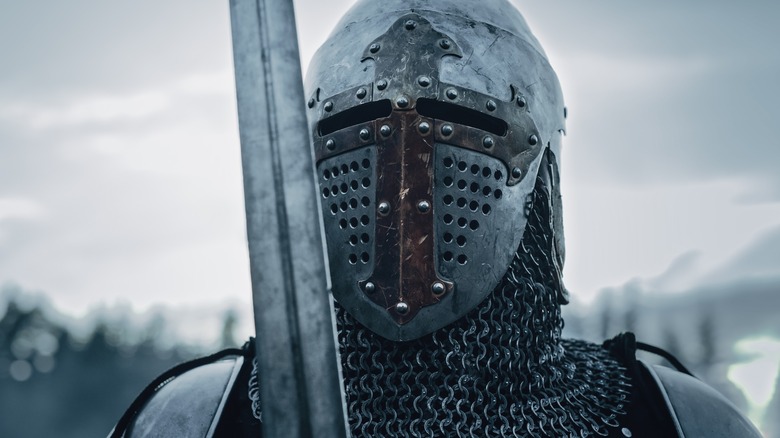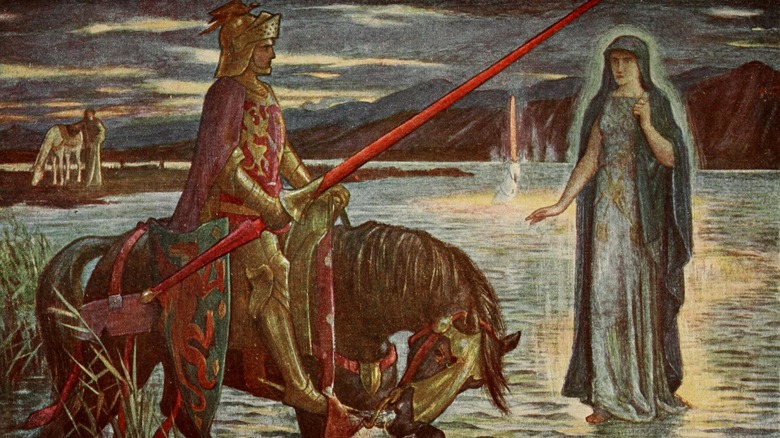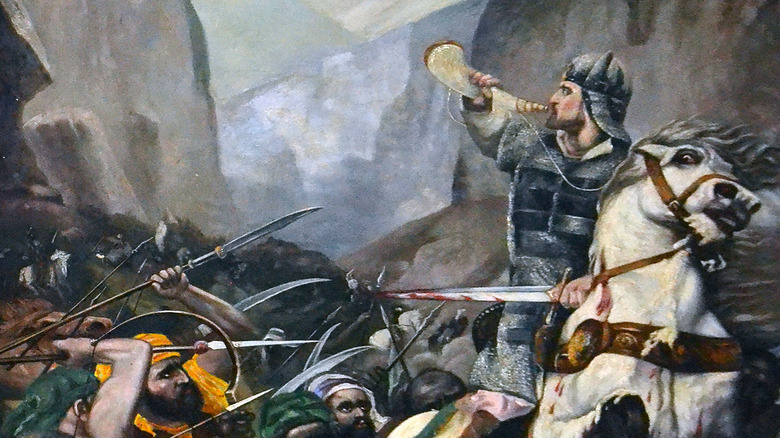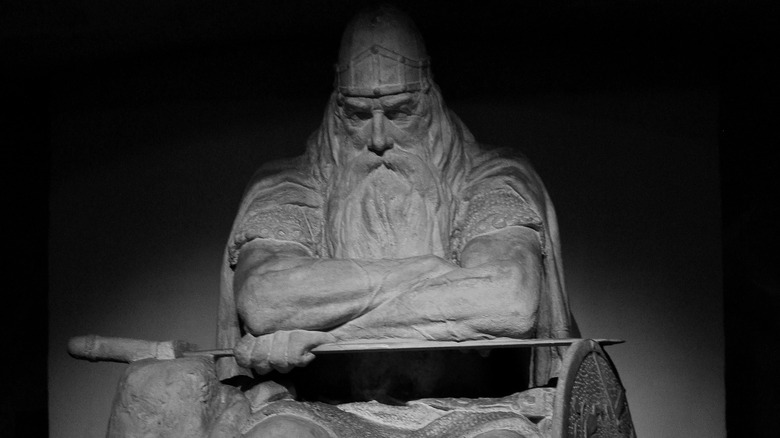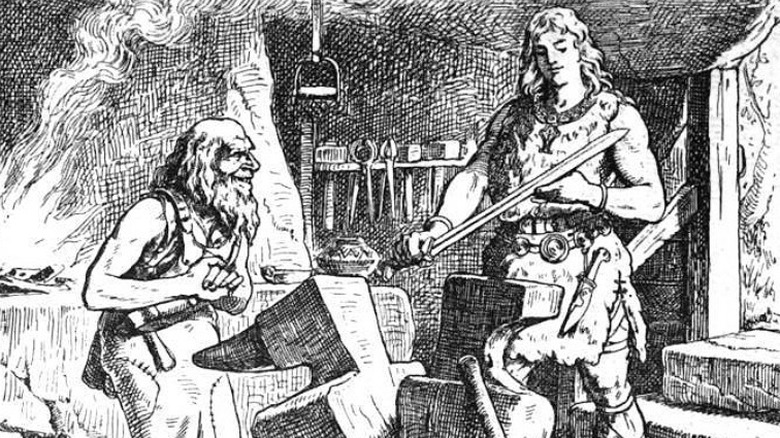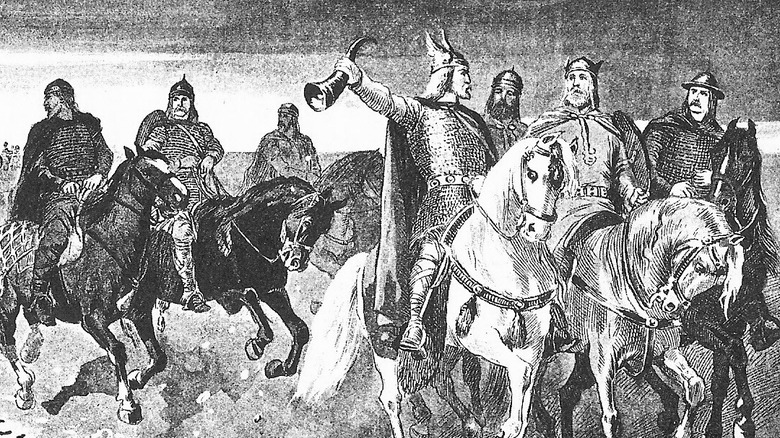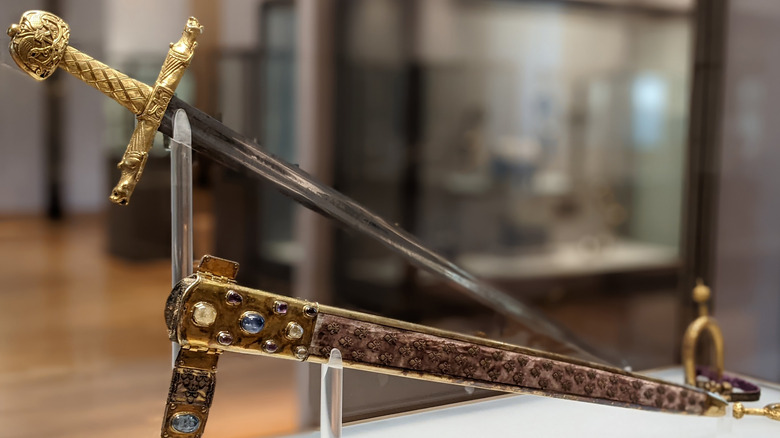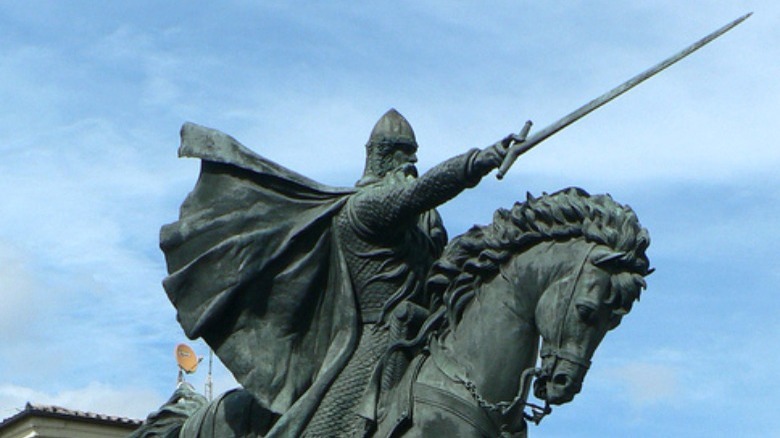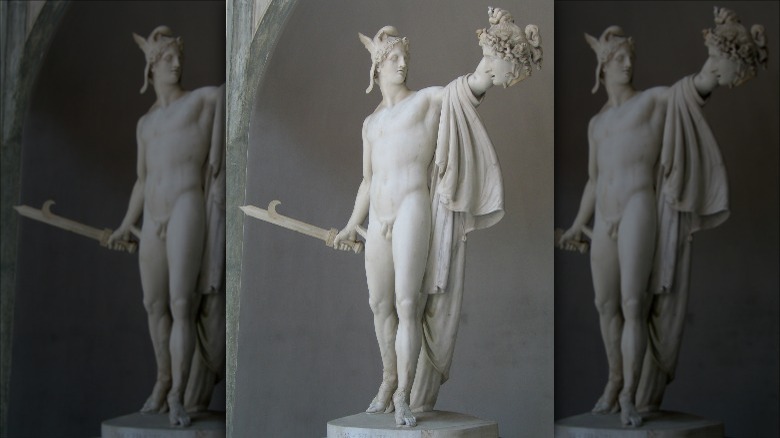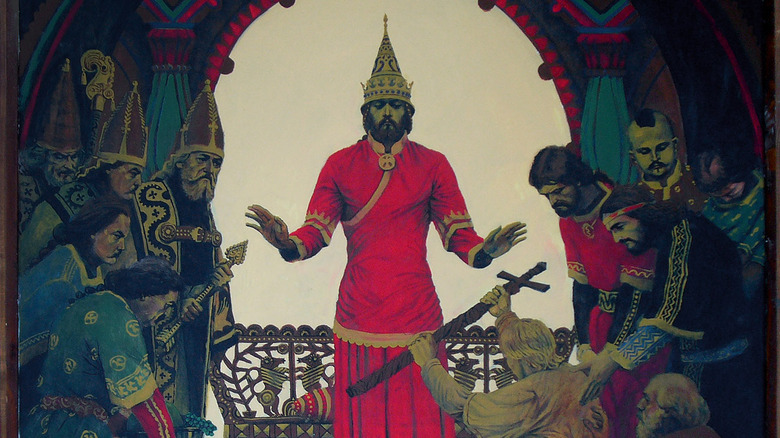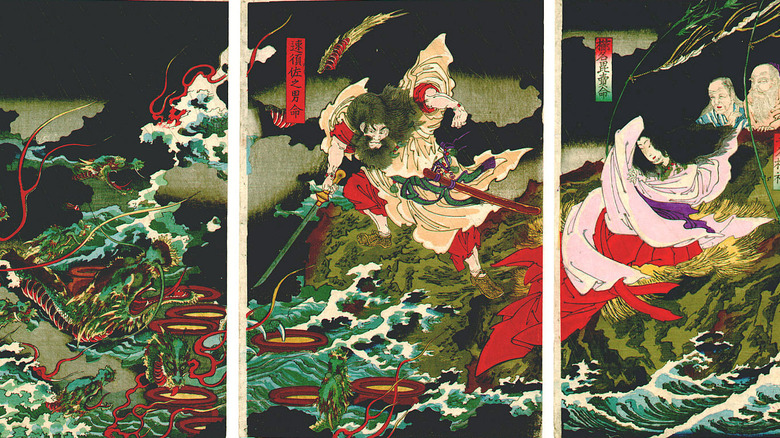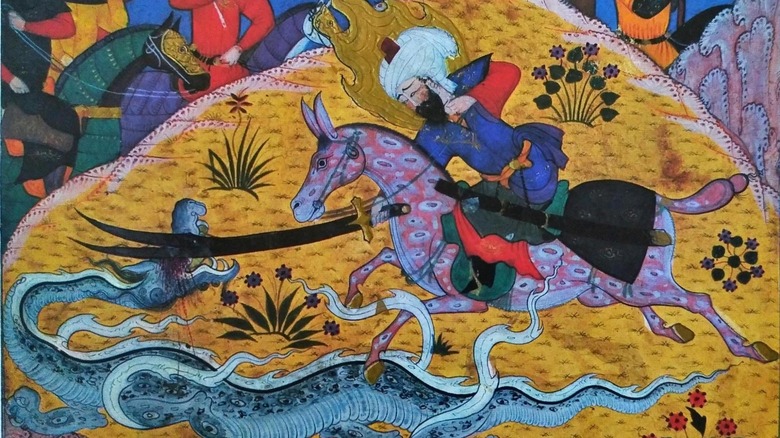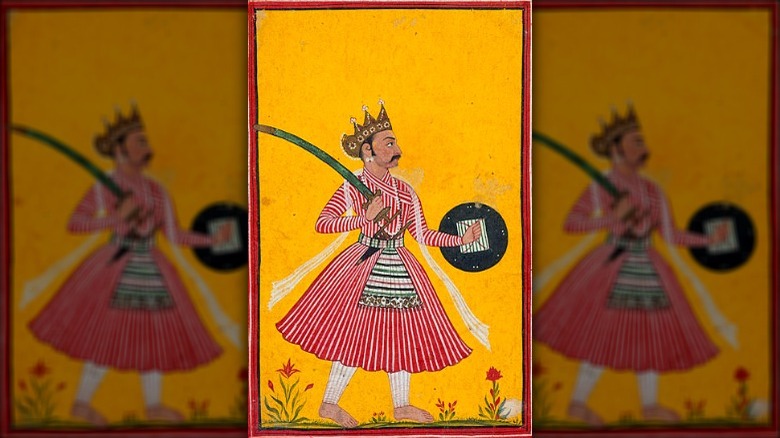Legendary Swords From Famous Myths
Look, let's face it: swords are extremely cool. The only thing cooler than a sword is a sword with a name and maybe also magic powers. The tellers of myths and legends from around the world know this intuitively, and it is for that reason that stories from just about every continent feature kickin' rad swords with supernatural origins, amazing powers, and memorable names. In fact, there are so many swords of legend that any one national mythology probably has enough to fill a list like this one with swords left over.
As a result, here is just a mere sampling of some of the famous swords held by legendary and historical heroes such as King Arthur, Charlemagne, and Perseus, and even some wielded by the gods themselves, like Susanoo, Odin, and Brahma. There are some here that are so famous that you've definitely heard of them, but we suspect there are plenty from cultures other than your own that might be new to you. And what better way to spend your time than learning about sick new swords?
The most famous sword of them all
No list of legendary swords would be complete without the most famous legendary sword of them all, Excalibur, the sword of Arthur, King of the Britons. Even people only marginally aware of the stories of King Arthur and his famous table of knights probably know that Arthur was proven to be the true king of Britain as a boy when he pulled a sword from a stone that no one else could budge. As Britannica explains, however, the Sword in the Stone is not always portrayed as the same sword as Excalibur. While some versions of the story do conflate the two swords, one of the most well-known versions of the life and death of Arthur – Thomas Malory's "Le Morte D'Arthur" – says that Arthur was given Excalibur by the magical Lady of the Lake, and the sword was returned to her by Arthur's knight Bedivere after the king's last battle.
The name Excalibur is likely ultimately derived from the name of a similarly legendary sword in Irish myth known as Caladbolg, which was rendered in Latin as Caliburnus by the author Geoffrey of Monmouth, eventually becoming the form we know today, with Malory explaining that the name means "cut steel." In Malory, however, the scabbard is more powerful than the sword itself: the World History Encyclopedia says that whoever held the scabbard could never be made to bleed, even by the most grievous wounds.
The unbreakable sword of Roland
While the primary legends of Britain surround King Arthur and his knights, the equivalent cycle of stories in France concerns the emperor Charlemagne and his paladins. In the same way that Lancelot is the greatest knight of the Round Table, the greatest of the paladins is Roland, who wields the mighty sword Durandal. According to Ancient Origins, Roland was the nephew of Charlemagne and was the finest of the Twelve Peers, the greatest warriors of the empire. His most famous tale is "The Song of Roland," which tells of Roland's last stand at the Battle of Roncevaux. In that poem, it is said that the mighty sword Durandal was given to Charlemagne by an angel, but the Italian epic "Orlando Furioso" says that the sword originally belonged to the Trojan hero Hector. "Orlando Furioso" goes as far as to say that stealing the sword was the main reason for the Saracen invasion that led to the Battle of Roncevaux.
"The Song of Roland" describes Durandal as having many holy relics built into it, including a tooth of Saint Peter, a scrap of the Virgin Mary's robe, and some of Jesus' hairs. Durandal's primary magic characteristic was being sharp without peer and completely unbreakable. In fact, when Roland tried to destroy the sword to keep it from falling into enemy hands, he accidentally created Roland's Breach, a 100-meter-high natural gap in the Pyrenees.
The blunt-tipped sword of mercy
There is a sword that ties together the knights of Arthur and the paladins of Charlemagne as well as the completely non-legendary British monarchy, and that sword is Curtana, which is also known as Cortana, Courtain, or the Sword of Mercy. As Naked History explains, legend holds that the sword was possessed by the Round Table knight Sir Tristram, who used the sword to combat an enemy knight only for the tip to break off in his foe's skull, giving Curtana both its signature characteristic – that is, a flat, square tip – and its name ("curtana" means "short"). This sword was then inherited by one of Charlemagne's knights, Ogier the Dane. The French sources say that Curtana was made of the same steel as Roland and Charlemagne's own swords, but say that it was Ogier himself who broke off the tip. Yet a third legend says that the sword's tip was broken off by an angel as a symbol of mercy at the coronation of Eleanor of Provence in 1236.
A sword said to be the sword of Tristram and Ogier is among the Crown Jewels of the United Kingdom – one of the few items to survive being destroyed by Oliver Cromwell – and is one of three swords used at coronations of kings and queens. It survives to this day and has been used in every coronation in the United Kingdom since the 13th century.
A dragon-slaying Viking sword
It probably won't surprise you that the culture that brought us the Vikings had a profound respect for a really good sword. As a result, Scandinavian legend gives us a number of famous named blades with interesting backstories, and out of those, probably the best known is Gram, the sword of the heroes Sigmund and Sigurd. As Britannica explains, the name "Gram" means "anger," and the sword originally belonged to the king of the gods, Odin, who thrust the blade into a tree as a prize for the man strong enough to pull it out. The sword, Odin promised, could only be removed by its rightful owner, who would never lose in battle while wielding it. The rightful owner turned out to be Sigmund, who uses it in several successful battles, only for it to eventually be broken by Odin himself.
In a scene that definitely inspired Tolkien, the blade is reforged by Sigmund's son Sigurd, with the help of the dwarf smith Regin. The reforged sword is so sharp that it is able to slice through wool floating on a river and strong enough to split the anvil on which it was forged in two. Sigurd uses Gram most famously to kill the dragon Fafnir, who had stolen the treasure of the Nibelungs. While the sword is best known by the name Gram, in other prominent works, it is also known by the names Balmung and Notung.
The greatest sword of the North
In addition to the famous myths of the gods told in the Eddas, the Norse people also told tales of figures both historical and legendary (often a mix of the two) in the various sagas that have been preserved to this day. One of these sagas, "The Saga of King Hrolf Kraki," tells of a Danish king who finds himself at odds with his half-elf half-sister Skuld. Hrolf's own sword, Skofnung, is referred to in that saga as "the best of all swords that have been carried in northern lands." According to Ancient Pages, Skofnung was famous for its supernatural sharpness and hardness, which was caused in part by being infused with the souls of Hrolf's 12 berserker bodyguards. As Timeless Myths explains, King Hrolf uses his renowned sword in a climactic Yule-day battle against his elven sister's supernatural army, which Skuld's army of monsters eventually wins, with Hrolf lying dead of exhaustion. He is buried with his famous sword by his side.
The sagas tell, however, of later heroes who extracted Skofnung from Hrolf's burial mound and used it to avenge great crimes. In these accounts, it is said that wounds caused by Skofnung's blade would never heal except by the magical Skofnung Stone, a healing stone attached to the sword. Likewise, the sword could never be drawn in the light of day or in the presence of a woman.
A holy blade fit for an emperor
As a couple of Charlemagne's knights had renowned and magical swords, it would be indecorous for the emperor not to have a famous blade of his own. In Charlemagne's case, the resplendent sword he held at his side in battle was the sword Joyeuse, whose name means "joyful." According to Ancient Origins, the famous blacksmith Galas constructed the sword for the king – and in many accounts, using shards of the Lance of Longinus, the spear used at the crucifixion of Jesus, to make the hilt – over the course of three continuous years of work. All this effort paid off, however, as the stories say that the sword shone so brightly that it would blind all enemies in battle, anyone who wielded it would be protected from poison, and that it magically changed color 30 times a day. One tale says that Charlemagne once lost Joyeuse in battle and promised a great reward to anyone who could find it. When a soldier found it, the emperor swore that he and his lineage would prosper in that place under the name of his sword. And the actual IRL town of Joyeuse still stands in southern France to this day.
As with Curtana, there is a real sword that has been identified as Joyeuse since the 13th century that was used in the coronation of French kings from that time until the French Revolution, since which time it has been in the Louvre.
The terrifying twin blades of El Cid
Just as the historical Frankish emperor Charlemagne grew to legendary proportions in French stories, so too did the real-life Spanish warlord Rodrigo Diaz de Vivar become larger than life in the stories told of him. As Britannica explains, Diaz was a Castilian warlord who became a national hero for his fierce and fearless fighting in the 11th century during the Muslim occupation of Spain. In Spanish, he was known as El Campeador ("the champion"), but he is more famously known by a name derived from the Arabic al-sīd, or "lord": El Cid. In the 12th century, an epic poem called "El cantar de mio Cid" ("The Song of My Cid") turned El Cid into a true legend, inflating his presence into an idealized medieval knight and exemplar of bravery, chivalry, and piety. It is, of course, in this poem that El Cid is given not one, but two legendary swords.
The first of the two swords is called Tizon (or Tizona, both meaning "firebrand"), which the poem calls "well worth a thousand golden marks." El Cid wins Tizon in battle with its previous owner, King Yussuf, and it is revealed that the power of the sword is proportional to its wielder. The stronger the one who holds it, the more powerful it is, to the point that it causes cowering fear in the hearts of unworthy opponents. His other sword, Colada, doesn't seem to have any magic powers.
The blade that slayed a Gorgon
Perhaps surprisingly, Greek mythology doesn't feature as many famous named weapons as later legends do. You kind of really want Achilles or Bellerophon or whoever to have a sword of great renown, and instead, Homer just goes on for paragraphs about what Achilles' shield looks like without even giving it a cool name. The one possible exception to this is the Harpe, the sickle-sword used by the hero Perseus to behead Medusa, among other great feats. The only issue is that "harpe" is the common noun name for that type of sword with a curved blade, coming from the Greek word meaning to snatch up or seize, which is also the word for a bird of prey.
Even if the sword of Perseus doesn't technically have a proper name, it's still pretty cool. Theoi records that the Harpe was given to Perseus by the gods to aid him on his quest to kill the Gorgon, together with flying sandals, a magic sack, and a hat that made him invisible. In some versions, these items are given to him by Hermes and Athena, in others, he has to travel the world to gather them from Nymphs. At any rate, he uses the sickle-sword to behead Medusa, and from her neck stump spring the winged horse Pegasus and Chrysaor, the Boy with the Golden Sword. The Harpe was a sword so cool that it spawned another cool sword.
The sword of the Scourge of God
Occasionally, tales of a completely historical figure get beefed up in legend, and as the examples of Charlemagne and El Cid have shown us, one cool way to do that is to give the person a sick sword. One other such person is the fifth-century Hunnic leader Attila, who is said to have carried an invincible sword that the Huns called the Sword of God, and which their Roman enemies called the Sword of Mars. As Naked History explains, legend says that this sword was crafted from meteoric iron by the gods of the Scythians to bring power to those people, but the sword was lost after being taken from the Scythians by the combined armies of the Huns and Magyars. The latter two forces were arguing about whether the Huns or Magyars should take the divine blade, so they had a blind man spin it in the air so that it would go in the direction it pointed when it landed. Instead, a powerful wind carried the sword away.
The legendary blade was later found by a Hunnic shepherd when one of his sheep cut itself on the sword lying hidden in the grass, and the man made a gift of the sword to Attila. The Huns rarely used swords as weapons, but for Attila, the Sword of God was a powerful symbol of his divinely-appointed invincible might.
A blade sharp enough to cut grass
Just as European knights were often imbued by storytellers with supernatural blades, Japanese folklore also liked to create larger-than-life swords, making superhumans out of both samurai warriors and even the craftsmen who made the blades. Per Japan Accents, one such legendary sword-maker was Muramasa, who, as a challenge, forged Juuchi Yosamu ("10,000 Cold Nights"), the blade of which was so sharp that when he laid it across the surface of the water, it sliced through everything that the current brought to it: leaves, fish, and even the air. So in a culture that reveres the craftsmanship of a sword like that, it makes sense that there would be some famous ones.
And probably the most famous legendary Japanese sword of all time is the divine sword Grass Cutter (Kusanagi-no-Tsurugi in Japanese). As Britannica explains, this sword was originally discovered by the storm god Susanoo inside the body of a great eight-headed dragon that he slew. He made a gift of the sword to his sister, the sun goddess Amaterasu, who subsequently gave it as a gift to her grandson Ninigi, as he went down to Earth to be the divine ruler of Japan. The sword received its popular name when the hero Yamato Takeru used it to cut his way out of a burning field of grass. While doing so, Yamato learned that the sword could summon great winds in the direction it swung.
A sword from Heaven
One of the most famous swords in all of Middle Eastern legend is Zulfiqar, wielded by Muhammad's cousin Ali ibn Abi Talib. As Raseef22 explains, during a particularly heated battle, Ali's original sword shattered into pieces, leading him to ask his cousin, the Prophet Muhammad, for a replacement. Muhammad asks God for a replacement sword, and the sword Zulfiqar miraculously appears. After Ali uses the sword to defeat their enemies and quell the murder attempt against Muhammad, legend says that the angel Gabriel appeared and gave the oft-quoted proclamation, "There is no hero like Ali; There is no sword like Zulfiqar." Some versions of the story say that Gabriel fashioned the sword himself from the scrap metal of a destroyed pagan idol, while other versions say that the blade was among the great treasures given to King Solomon by the Queen of Sheba.
Whatever the case, the sword – which in traditional depictions has a split tip or a double-pronged blade – has become an important political symbol, especially among Shiite Muslims. Possession of the sword is believed to imbue those who hold it with legitimacy as the successors of Muhammad, as well as serving as a source of inspiration, just as it had for the followers of Ali. As such, the iconic double-bladed design can be found on a number of different flags, including those for the Ottoman Empire.
The first sword of them all
As the Sword Library records, the famous Sanskrit epic the Mahabharata tells of the master swordsman Nakula asking the great warrior Bhishma Pitamah which type of weapon is the greatest of them all. While the bow was popularly considered the best, Nakula felt certain it must be the sword. When he asked Bhishma to tell him more about the sword, the older man laid out the history of the creation of the very first sword, Asi. In the distant past, he said, the world was full of demons, so the gods turned to Brahma, the great god of creation, for help. In response, he caused the ground to open up in a literally earth-shattering display of power and rain of fire. From the swirling depths arose a hideous creature with razor teeth, shining with blue light. This creature was Asi, whom Brahma commanded to shapeshift into a flaming sword that could be used to defeat the demons and restore righteousness to creation.
The sword Asi was given to the storm god Rudra, Destroyer of Evil. Rudra transformed into a giant four-armed swordsman and proceeded to lay waste to the demons until the Earth was filled with their dead bodies. Once righteousness had been restored, Rudra gave the sword to a succession of righteous wielders, including the human Manu, who was essentially the Hindu version of Noah.
